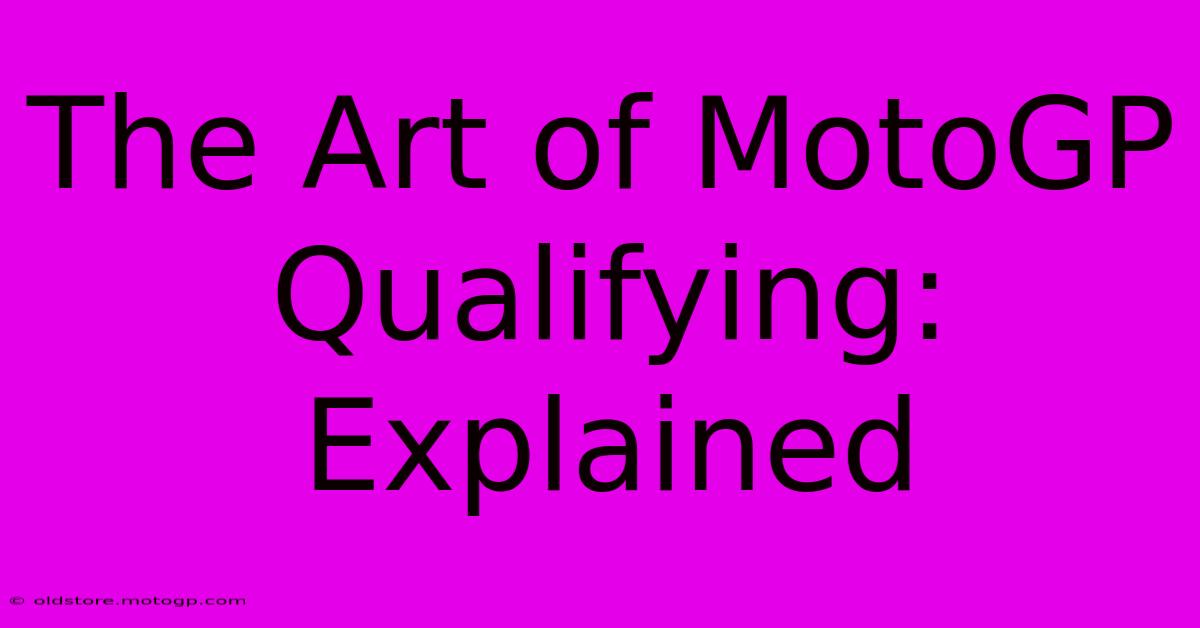The Art Of MotoGP Qualifying: Explained

Table of Contents
The Art of MotoGP Qualifying: Explained
MotoGP qualifying. The nerve-wracking, tire-shredding, last-gasp battle for pole position. It's more than just a quick lap; it's a strategic chess match demanding precision, skill, and a touch of luck. This article delves into the intricacies of MotoGP qualifying, explaining the process, the strategies employed, and the factors contributing to success.
Understanding the Qualifying Format
The current MotoGP qualifying format aims to deliver maximum excitement and ensure the fastest riders are rewarded. It's a multi-stage process that whittles down the field, culminating in a nail-biting final shootout.
Q1: The First Cut
The session starts with Q1, featuring the riders who didn't finish within the top 10 in the combined times from the previous Free Practice sessions (FP1, FP2, and FP3). This is a high-stakes battle where 15 riders fight for only two coveted spots in Q2. Every tenth of a second counts as riders push their machines and themselves to the absolute limit. Mistakes here can be incredibly costly. Strategy in Q1 often involves finding a clear track and managing tire wear for a single, fast lap.
Q2: The Decisive Showdown
The top 10 riders from the combined free practice sessions proceed directly to Q2. Joined by the two fastest riders from Q1, these 12 riders compete for pole position and the coveted front row grid slots. The pressure is immense, with riders battling for the optimal slipstream and pushing their bikes to the very edge of their capabilities. Tire management becomes crucial here; a perfect qualifying lap requires a balance between grip and longevity. The tiniest error can result in a crash or a significantly slower lap time.
Key Factors Influencing Qualifying Performance
Several key factors contribute to a rider's success in qualifying:
1. The Bike's Setup:
A perfectly tuned machine is the foundation of a fast lap time. Engineers work tirelessly to optimize the bike's suspension, electronics, and aerodynamics for the specific track conditions. Even minor adjustments can make a significant difference in lap time.
2. Rider Skill and Fitness:
MotoGP racing demands peak physical and mental condition. Riders need exceptional skill, reflexes, and the ability to maintain focus under extreme pressure. Physical fitness is also essential, as riders endure intense G-forces throughout the session.
3. Track Conditions:
The track's temperature, grip level, and even the wind can significantly affect performance. Riders and teams carefully monitor these conditions and adapt their strategies accordingly. Weather plays a significant role; a sudden rain shower can completely alter the qualifying session.
4. Tire Choice and Management:
Selecting the right tires and managing their wear is crucial. Riders must balance the need for grip with the risk of overheating or wearing out the tires prematurely. This is a constant assessment during the session.
5. Slipstream (Drafting):
Drafting another rider's wake can significantly improve speed, particularly on long straights. Riders strategically position themselves to gain an advantage from the slipstream, adding another layer of complexity to the qualifying battle. This requires precise timing and tactical awareness.
The Importance of Pole Position
Securing pole position provides a significant advantage in the race. Starting from the front row allows riders to control the race pace and avoid getting caught in battles further back on the grid. It provides a strategic advantage, offering a better chance of victory.
Conclusion: The Art of the Perfect Lap
MotoGP qualifying is a high-octane display of skill, strategy, and precision. It's a critical element of the weekend, influencing race outcomes significantly. The art of achieving pole position involves a perfect harmony of rider skill, bike setup, and strategic decision-making under immense pressure. Understanding the intricacies of qualifying provides a deeper appreciation for the dedication and talent of these world-class athletes.

Thank you for visiting our website wich cover about The Art Of MotoGP Qualifying: Explained. We hope the information provided has been useful to you. Feel free to contact us if you have any questions or need further assistance. See you next time and dont miss to bookmark.
Featured Posts
-
Moto Gp Qualifying Session Sets The Tone For The Weekend
Feb 19, 2025
-
Moto Gp Engines Pushing The Boundaries Of Speed And Innovation
Feb 19, 2025
-
The Collectors Edition Cota F1 Merchandise
Feb 19, 2025
-
F1 Parking Avoid The Last Minute Rush
Feb 19, 2025
-
Moto Gp Qualifying Everything You Need To Know About The Grid
Feb 19, 2025
